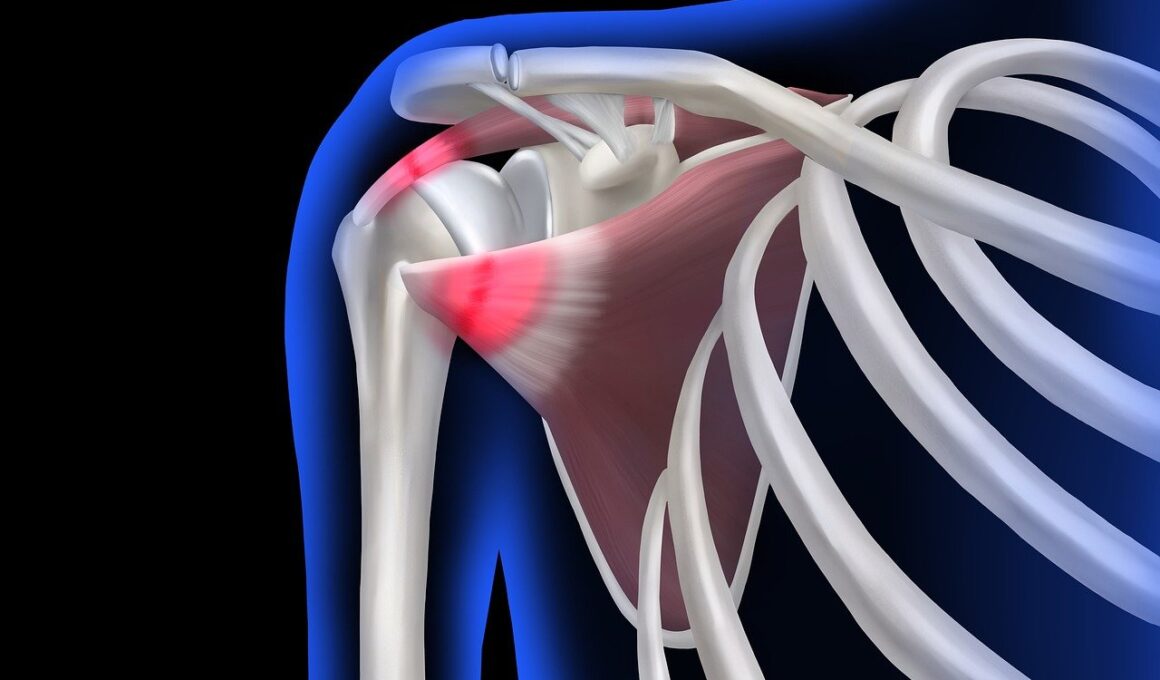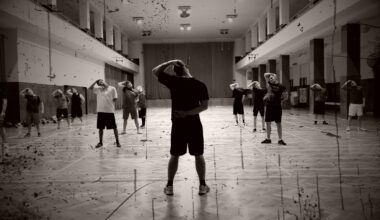How to Avoid Shoulder Strain During Kettlebell Rows
Kettlebell rows are fantastic for building upper body strength; however, they can lead to shoulder strain if not performed correctly. To prevent injury, start with proper setup and form. Begin by choosing an appropriate weight; a kettlebell that is too heavy can compromise your technique. Stand with your feet hip-width apart and hinge forward from your hips, keeping your back straight and core engaged. It’s crucial to maintain a neutral spine throughout the movement, as this supports shoulder stability. When pulling the kettlebell towards you, lead with your elbow and ensure your shoulder blade retracts gently. By focusing on the movement of the shoulder blades rather than the arms, you reduce strain on the shoulder joint itself. Always warm up properly before your workout to prepare your muscles and joints for load. Incorporating shoulder mobility exercises into your routine can also enhance your range of motion, reducing the likelihood of pain. Lastly, don’t hesitate to seek guidance from a fitness professional if you’re unsure of your technique.
Engaging the right muscle groups is essential for effective kettlebell rows while protecting your shoulders. To ensure you’re targeting the correct muscles, focus on squeezing your shoulder blades together as you row. This motion activates your back muscles effectively, allowing you to distribute the load more evenly. One key aspect of preventing shoulder strain is maintaining proper shoulder positioning. Keep your shoulders down and away from your ears throughout the movement. Avoid allowing your shoulders to creep up as you pull the kettlebell. Additionally, you may find it beneficial to integrate unilateral training; that is, executing rows one arm at a time. This method can prevent imbalances and enhance your control, thus promoting better shoulder stability. Moreover, be mindful of your breathing; inhale during the lowering phase and exhale as you pull the kettlebell up towards your torso. Keeping your breath steady ensures you don’t hold tension, which could further exacerbate shoulder strain. Experiment with different grips too; a neutral grip often feels more comfortable and can ease strain on the shoulders compared to an overhand grip.
Listening to Your Body
Listening to your body during kettlebell rows can significantly influence your ability to stay injury-free. If you start feeling discomfort, particularly in your shoulders, don’t ignore those signals. Stop, assess your form, and modify your technique as needed. Your body has a unique way of communicating when something isn’t right. If you routinely experience pain, consider reducing the weight or modifying the exercise. There are alternative rows, like the dumbbell row, that might work better for your body mechanics. Furthermore, ensuring you’re adequately hydrated can also impact your performance and comfort level. Dehydration can lead to muscle cramps, making you more susceptible to injury during lifting. Aim to drink water before, during, and after your workout. Equally important, allow enough time for recovery; don’t work the same muscle groups on consecutive days. Resting allows your shoulder muscles time to recover and rebuild, diminishing the risk of strain. You might also want to integrate effective stretch routines or foam rolling exercises post-workout to promote mobility and reduce tension in your shoulders.
Proper equipment usage can enhance both performance and safety during kettlebell rows. Ensure your kettlebell is in good condition, without any damage or excessive wear. Selecting the right surface for your workouts is also critical; a flat and stable surface helps maintain balance. If you tend to row regularly, consider using a mirror to observe your form. This visual feedback can be instrumental in correcting any mistakes immediately. Utilize a mat for comfort and stability, especially if you perform rows in a bent-over position. When arranging your kettlebell workouts, it’s wise to include variety for overall shoulder health. Incorporating exercises like face pulls or band pull-aparts can help strengthen the supporting muscles around the shoulder. Strengthening these areas allows your shoulders to accommodate heavier loads during kettlebell rows while reducing strain. Moreover, utilizing resistance bands in your warm-up can prime your shoulder muscles and improve stability. Resistance bands can be very beneficial in activating the rotator cuff muscles, which play a crucial role in shoulder joint stability. Pay attention to body mechanics, and ensure you’re aligned correctly to foster safe, effective workouts.
Recovery and Rehabilitation
After a kettlebell workout, recovery techniques are essential to minimize shoulder strain and enhance performance. Implementing cooldown protocols is vital to helping muscles return to their normal state after exercise. Engage in static stretches targeting the shoulders, such as doorway stretches or cross-body arm stretches, to enhance flexibility and alleviate tension. Incorporating foam rolling techniques into your recovery routine can also break down tight fascia and improve blood flow, which aids recovery. If you continually experience shoulder pain, consider consulting a physical therapist for specialized guidance. A therapist can develop a customized rehabilitation program specific to your needs, helping to address underlying issues related to your shoulder mechanics. Additionally, consider the use of ice and heat treatments; applying ice reduces inflammation while heat promotes blood flow, expedites healing, and relieves stiffness. Integrating restorative exercises into your weekly routine can enhance recovery as well. Practices like yoga or pilates foster strength, flexibility, and relaxation. Prioritize sleep quality, as it’s critical for overall recovery. A good night’s sleep allows your body to effectively reset, ultimately improving your performance and recovery after kettlebell workouts.
Nutritional support plays a crucial role in avoiding shoulder strain during kettlebell rows. Your muscles require adequate nutrition to function optimally and recover from intense workouts. Prioritize a balanced diet rich in protein, healthy fats, and complex carbohydrates to fuel your workouts effectively. Protein, in particular, is vital for muscle repair; consider incorporating sources like chicken, fish, beans, or protein shakes post-exercise. Additionally, consider the timing of your meals; eating a nutrient-dense meal or snack before and after your workouts ensures that your body is adequately fueled and equipped to recover. Anti-inflammatory foods such as turmeric and ginger can help reduce muscle soreness and inflammation, benefiting your overall training regimen. Don’t forget the importance of micronutrients, such as magnesium and calcium, which support muscle function and bone health. Hydration cannot be overlooked either; aim to drink plenty of water, especially after workouts. Replenishing lost fluids enables your body to recover efficiently. Lastly, listen to your cravings; sometimes they indicate nutrient deficiencies, so honor those cues. Pay attention to how your body feels and adjust your diet as needed to maintain strength and performance.
Consistency and Progression
Consistency is vital for safely advancing in kettlebell rows while avoiding shoulder strain. Establish a regular training schedule that allows for adequate recovery between sessions. Gradually increasing the weight or volume of your kettlebell workouts enables your muscles to adapt without incurring injury. Consider implementing a systematic progression strategy; for instance, apply the 10% rule whereby you increase weights by no more than 10% per week. Keeping a workout log helps track your progression and adjusts load appropriately based on how your body responds. Additionally, integrating alternative exercises like upright rows or bent-over dumbbell flyes can diversify your regimen, reducing the repetitive stress on your shoulders. Monitor your body’s feedback continuously as you progress, always prioritizing form over weight. Prioritize technique improvements over lifting heavier kettlebells to sustain shoulder health. Practicing patience is essential; don’t rush your progress, as it could lead to unwanted injuries. Embrace rest days as vital components of your training. Finally, stay motivated by setting realistic yet challenging fitness goals that encourage personal growth while remaining mindful of your body’s limits.


